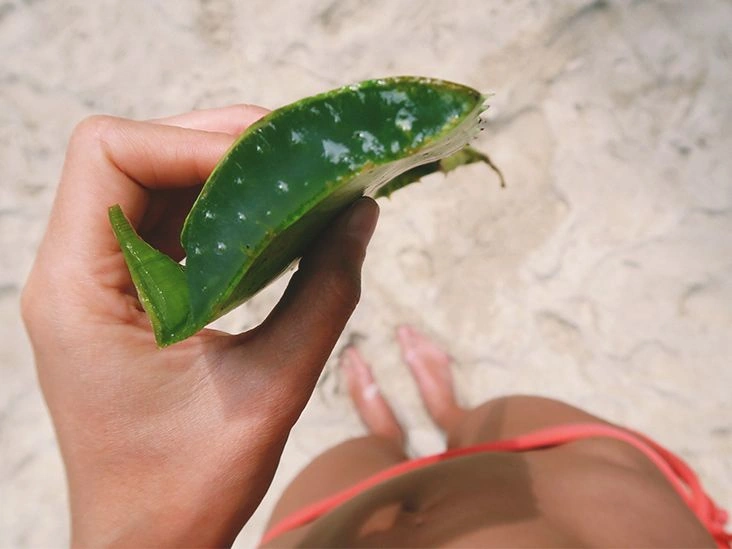Numerous studies indicate that the clear, jelly-like substance found inside the thick leaves of an aloe vera plant can aid the recovery process after a sunburn.
Aloe vera is a tropical medicinal plant used for millennia to treat skin ailments like wounds and burns. Its effectiveness at soothing burns has earned it the nickname “the burn plant.”

Can aloe vera speed sunburn recovery?
Some older peer-reviewed research demonstrates that aloe vera supports healing of first- and second-degree burns, which encompass mild to moderate sunburns.
In more recent research, a compound in aloe called aloin was identified as a contributor to the plant’s anti-inflammatory properties. Aloe vera also helps hydrate the skin and can reduce the peeling that often accompanies sunburn.
How to apply aloe vera for sunburn relief
For a sunburn, smooth a layer of pure gel extracted from the inside of an aloe leaf onto the affected area. You can cultivate your own aloe plant at home or purchase aloe extracts from stores or online.
Aloe vera works best when it’s 100 percent gel and chilled. Apply aloe a few times daily to the burned region. For severe burns—sometimes called sun poisoning—consult a healthcare professional before using aloe.
Do not try to manage third- or fourth-degree burns or severe sunburns at home using aloe vera. These injuries are medical emergencies and require hospital treatment.
Aloe vera can be utilized in several forms:
Direct from the plant
If you have an aloe plant, cut off a piece. Gel will exude from the interior—apply this gel straight to the skin to ease a minor sunburn.
Pure gel
If you don’t have a plant, buy a product labeled 100 percent aloe vera gel from a pharmacy or online. Spread a layer of the gel directly on the burn.
Lotions
Aloe-containing lotions are sold in stores and online. Avoid items with dyes or fragrances. Choose a product with the highest aloe vera content possible.
That said, one study found no advantage to using a 70 percent aloe lotion on sunburns, so pure gel may be preferable.
Consuming raw aloe
You can also eat raw aloe gel straight from the plant. While ingesting the gel may offer health advantages such as reducing systemic inflammation, it won’t relieve the local pain and irritation of a sunburn.
If you decide to eat aloe, thoroughly rinse away any latex or skin to remove bitter-tasting latex, which can cause adverse effects.
Do not ingest aloe-containing lotions or gels made for topical use; they aren’t formulated as food and may include ingredients unsafe to swallow.
Why does skin get sunburned?
Sunburn happens when ultraviolet (UV) radiation from the sun or artificial sources like tanning beds damages DNA within skin cells. The damaged cells undergo programmed cell death, or apoptosis.
This rapid cell death triggers the immune system to release inflammatory molecules. Blood vessels dilate to deliver immune cells to the injured skin, producing the redness, soreness, and tenderness typical of sunburn.
Burns, including sunburns, are categorized by severity:
- First-degree burn affects only the outer skin layer and causes mild pain, redness, and swelling.
- Second-degree burn harms deeper skin layers and produces blisters and shiny, pale-appearing skin.
- Third-degree burn damages all layers of the skin.
- Fourth-degree burn injures the skin and may extend to joints and bone.
The initial measures to treat a sunburn are to take a cool shower or apply a cool compress to the burned skin. For discomfort, use over-the-counter pain relievers such as ibuprofen or aspirin. If blisters form, avoid popping them to reduce infection risk.
You can apply a moisturizer or aloe gel to keep the area hydrated and lessen inflammation while it heals. Stay well-hydrated, since sunburn can lead to dehydration.
Are there side effects from using aloe vera for sunburn?
Topical application of aloe vera gel is unlikely to produce harmful side effects, according to available evidence.
Ingesting aloe could cause abdominal cramping, diarrhea, or worsening constipation. Aloe has laxative effects when eaten, which can lead to electrolyte disturbances.
Are there risks from using aloe vera on sunburns?
There is a small risk of an allergic reaction to aloe vera or other components in aloe products. People who are allergic to garlic, onions, or tulips may be more prone to an aloe allergy.
Before applying aloe to a large area, conduct a patch test on a small skin area and wait an hour or two to check for a reaction. If you develop an allergy to aloe, stop using it immediately.
Other potential benefits of aloe vera
Aloe vera may offer several additional benefits when applied topically or consumed. These can include:
- helping keep skin hydrated and clear
- relieving constipation (when ingested)
- easing heartburn (when ingested)
- lowering blood sugar in some people with type 2 diabetes (when ingested)
- serving as a mouth rinse alternative; swishing aloe may help reduce plaque and soothe bleeding or inflamed gums
- promoting healing of anal fissures when applied locally
- improving dry or damaged hair when used on the scalp
The takeaway
For a bad sunburn, applying aloe vera can encourage healing and alleviate pain and swelling.
While clinical studies haven’t definitively proven that aloe vera heals sunburn, research indicates that compounds in aloe exert anti-inflammatory effects on damaged skin.
Even if aloe helps with pain and redness, watch for signs of dehydration or heat-related illness such as extreme thirst, lack of urine output, nausea, or vomiting.
Seek immediate medical attention if you develop a fever with your sunburn or if blisters cover a large portion of your body.
Although aloe vera can assist after a burn occurs, remember that sunburns inflict serious damage to skin and DNA. Prevention remains essential.
When outdoors, protect your skin with sunscreen, hats, sunglasses, appropriate clothing, and seek shade whenever possible.


















Leave a Reply
You must be logged in to post a comment.